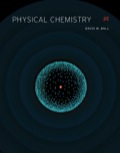
EBK PHYSICAL CHEMISTRY
2nd Edition
ISBN: 8220100477560
Author: Ball
Publisher: Cengage Learning US
expand_more
expand_more
format_list_bulleted
Question
Chapter 14, Problem 14.72E
Interpretation Introduction
Interpretation:
Two equations,
Concept introduction:
Spectroscopy method is used to identify the structure of the molecule. It is based on the interactions between matter and
Expert Solution & Answer
Want to see the full answer?
Check out a sample textbook solution
Students have asked these similar questions
What is the correct number of sig figs to the answer to this equation??
Chapter 13 is a Homework question. question 47. Please explain how can I do it without graphing it because if this question comes on the test how can I quickly solve this question without any graph and do it mathematically? If possible can you make a video? Thank you.
Chapter 14 Solutions
EBK PHYSICAL CHEMISTRY
Ch. 14 - Prob. 14.1ECh. 14 - Determine if the following integrals can be...Ch. 14 - What is the frequency of light having the...Ch. 14 - What is the wavelength of light having the given...Ch. 14 - What is the energy of light having each...Ch. 14 - The Cu(H2O)62+ complex has octahedral symmetry. Is...Ch. 14 - What are the wavelength, speed, and energy of a...Ch. 14 - Prob. 14.8ECh. 14 - Prob. 14.9ECh. 14 - Prob. 14.10E
Ch. 14 - Prob. 14.11ECh. 14 - Prob. 14.12ECh. 14 - Prob. 14.13ECh. 14 - Prob. 14.14ECh. 14 - Diatomic sulfur, S2, was detected in the tail of...Ch. 14 - Prob. 14.16ECh. 14 - Prob. 14.17ECh. 14 - Prob. 14.18ECh. 14 - Prob. 14.19ECh. 14 - Prob. 14.20ECh. 14 - Prob. 14.21ECh. 14 - Prob. 14.22ECh. 14 - Which of the following molecules should have pure...Ch. 14 - Which of the following molecules should have pure...Ch. 14 - The following are sets of rotational quantum...Ch. 14 - The following are sets of rotational quantum...Ch. 14 - Derive equation 14.21 from the E expression...Ch. 14 - Prob. 14.28ECh. 14 - Prob. 14.29ECh. 14 - Lithium hydride, 7Li1H, is a potential fuel for...Ch. 14 - Prob. 14.31ECh. 14 - Prob. 14.32ECh. 14 - Prob. 14.33ECh. 14 - Prob. 14.34ECh. 14 - Prob. 14.35ECh. 14 - Prob. 14.36ECh. 14 - From the data in Table 14.2, predict B for DCl D...Ch. 14 - A colleague states that the pure rotational...Ch. 14 - Prob. 14.39ECh. 14 - Prob. 14.40ECh. 14 - Prob. 14.41ECh. 14 - Prob. 14.42ECh. 14 - Prob. 14.43ECh. 14 - Determine E for J=20J=21 for HBr assuming it acts...Ch. 14 - Determine the number of total degrees of freedom...Ch. 14 - Determine the number of total degrees of freedom...Ch. 14 - Prob. 14.47ECh. 14 - Prob. 14.48ECh. 14 - Prob. 14.49ECh. 14 - Prob. 14.50ECh. 14 - Prob. 14.51ECh. 14 - Prob. 14.52ECh. 14 - Prob. 14.53ECh. 14 - Prob. 14.54ECh. 14 - Prob. 14.55ECh. 14 - Prob. 14.56ECh. 14 - Prob. 14.57ECh. 14 - Prob. 14.58ECh. 14 - Prob. 14.59ECh. 14 - Prob. 14.60ECh. 14 - Prob. 14.61ECh. 14 - Prob. 14.62ECh. 14 - Prob. 14.63ECh. 14 - Prob. 14.64ECh. 14 - Prob. 14.65ECh. 14 - Prob. 14.66ECh. 14 - Prob. 14.68ECh. 14 - Prob. 14.69ECh. 14 - Prob. 14.70ECh. 14 - Prob. 14.71ECh. 14 - Prob. 14.72ECh. 14 - Prob. 14.73ECh. 14 - Prob. 14.74ECh. 14 - Prob. 14.75ECh. 14 - Prob. 14.76ECh. 14 - Prob. 14.77ECh. 14 - Prob. 14.78ECh. 14 - Prob. 14.79ECh. 14 - Prob. 14.80ECh. 14 - Prob. 14.81ECh. 14 - Prob. 14.82ECh. 14 - Prob. 14.83ECh. 14 - Prob. 14.84ECh. 14 - Prob. 14.85ECh. 14 - Dioctyl sulfide, (C8H17)2S, and hexadecane,...Ch. 14 - Where would you expect vibrations for ethyl...Ch. 14 - Prob. 14.88ECh. 14 - Prob. 14.89ECh. 14 - Prob. 14.90ECh. 14 - Prob. 14.91ECh. 14 - Prob. 14.92ECh. 14 - Prob. 14.93ECh. 14 - Prob. 14.94ECh. 14 - The mutual exclusion rule states that for certain...Ch. 14 - Prob. 14.96ECh. 14 - Prob. 14.97ECh. 14 - Prob. 14.98ECh. 14 - Prob. 14.99ECh. 14 - Construct and compare the energy level diagrams...Ch. 14 - Prob. 14.101E
Knowledge Booster
Similar questions
- Show that another form of the Michaelis-Menten equation is rate=V[S]K+[S]arrow_forwardDetermine the value of the derivative {[(G)]/T}p for the solid-state reaction 2Al+Fe2O3Al2O3+2Fe Hint: See exercise 3.57.arrow_forwardRefer to Example 20.2 and explain whether any useful information can be obtained by comparing the second and the third set of data.arrow_forward
- What is the kinetic energy of a single atom of mercury that has a speed of 200m/s? This is a good speed for Hg atoms at room temperature. What is the kinetic energy of a mole of Hg atoms having that speed?arrow_forwardUse equation 17.56 to determine the change in energy, E, when 1mole of Ar is heated from 298K to 348K at constant volume. Compare this result with the change in energy calculated using massspecific heatchange in temperature. The specific heat of argon is 20.79J/(molK).arrow_forward
arrow_back_ios
arrow_forward_ios
Recommended textbooks for you
 Physical ChemistryChemistryISBN:9781133958437Author:Ball, David W. (david Warren), BAER, TomasPublisher:Wadsworth Cengage Learning,
Physical ChemistryChemistryISBN:9781133958437Author:Ball, David W. (david Warren), BAER, TomasPublisher:Wadsworth Cengage Learning, World of ChemistryChemistryISBN:9780618562763Author:Steven S. ZumdahlPublisher:Houghton Mifflin College Div
World of ChemistryChemistryISBN:9780618562763Author:Steven S. ZumdahlPublisher:Houghton Mifflin College Div

Physical Chemistry
Chemistry
ISBN:9781133958437
Author:Ball, David W. (david Warren), BAER, Tomas
Publisher:Wadsworth Cengage Learning,

World of Chemistry
Chemistry
ISBN:9780618562763
Author:Steven S. Zumdahl
Publisher:Houghton Mifflin College Div